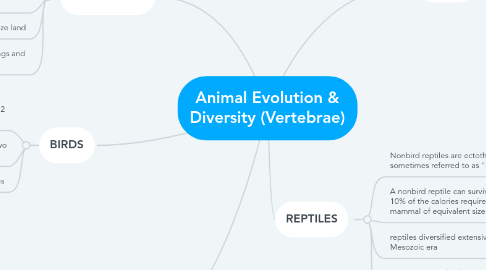Animal Evolution & Diversity (Vertebrae)
by faten amira


1. AMPHIBIANS
1.1. Exhibit a mixture of aquatic and terrestrial adaptations
1.2. Usually need water to reproduce
1.3. Typically undergo metamorphosis from an aquatic larva to a terrestrial adult
1.4. were the first vertebrates to colonize land
1.5. Descended from fishes that had lungs and fins with muscles
2. BIRDS
2.1. birds evolved from a lineage of small, 2 legs dinosours
2.2. -honeycombed bones, one instead of two ovaries, a beak instead of teeth
2.3. endotherms
3. MAMMAMLS
3.1. monotremes
3.2. marsupials
3.3. eutherians
3.4. humans are primates, includes:-
3.4.1. apes
3.4.2. monkeys
3.4.3. pottos
3.4.4. evoloved from insect-eating mammals
3.4.5. characteristics
3.4.5.1. limber shoulder joints
3.4.5.2. eyes infront of the eyes
3.4.5.3. excellent eye-hand coordination
3.4.5.4. extensive parental care
4. FISHES
4.1. evolved about 542 mya
4.2. 2 major groups
4.2.1. Cartilaginous fishes
4.2.2. Bony fishes
4.3. Cartilaginous and bony fishes have a lateral line system that detects minor vibrations in the water
4.4. To provide lift off the bottom:
4.4.1. cartilaginous fish must swim but
4.4.2. bony fish have swim bladders, gas filled sacs that make them buoyant
4.5. Fish Diversity Lampreys
4.5.1. are vertebrates
4.5.2. have a cranium
4.5.3. but lack jaws
